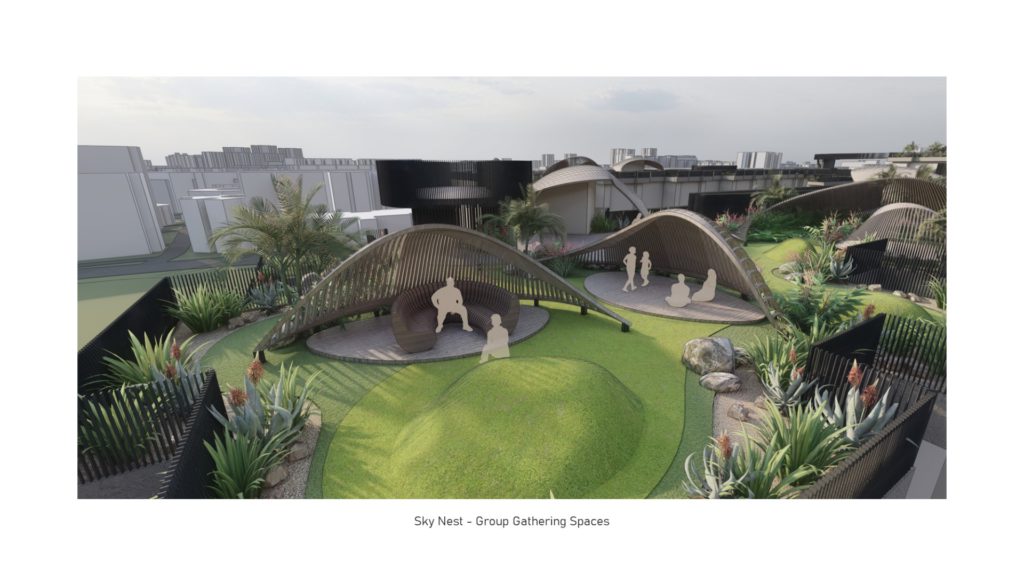The Nest: Supporting neighbourhood spaces with mental healthcare tech
June 23, 2022

City life is often described as stressful. Cities are associated with 39 per cent higher risk of depression, 21 per cent more anxiety and other negative effects from sensory overload and low social cohesion.1 In the bustling, fast-moving city-state of Singapore, almost ten per cent of its its 5.6 million population met the criteria for depression, anxiety and stress,2 but only less than one per cent (around 50,000) are seeking therapy.3
What if city spaces, combined with latest technology, could be utilised to normalise mental self-care and the treatment of depression/anxiety into people’s everyday lives?
The Nest, a proposal by Year 5 students at the National University of Singapore (NUS), taps into what they envision to be a data-driven landscape by 2030 to create smart neighbourhoods that could encourage checking in with one’s mental health through a range of flexible support systems.
Spaces for respite and relaxation

The team conducted interviews and surveys among their target group. Based on the results, they devised a series of spaces that could be conducive for the prevention and treatment of depression and reduce barriers towards professional help, making use of residential rooftops (Sky Nest) and canals (Canal Nest). There are three types of spaces: an ‘alone space’, a heart-to-heart talking space and a psychotherapy space.
These are designed as pavilion shells that could offer various scales of privacy, since the surveys identified that interweaving the surrounding environment and changing ‘atmospheres’ could be a helpful factor for users. The spaces are not demarcated with harsh boundaries, as the team wanted to avoid a sense of stigmatisation, self-doubt or anxiety amongst the users. This neutrality is meant to welcome everyone into the space, be it those who are undergoing treatment or those who may not see themselves having depression.
The insertion of organic-shaped pavilions also had the aim of ‘softening’ urban landscapes. “We wanted to break the monotony of the hardscapes in the typical Singaporean neighbourhood,” wrote the team. “Understanding from research that urban architecture could influence one’s mind in a positive or negative way … we looked at the rooftop and canal spaces as not just an extension of existing spaces of relaxation, but also as an escape from the city if one desires to do so.”
Gadget companion
Sensors in the environment are envisioned to collect data that will be integrated through an artificial intelligence (AI) cloud with a gadget called Bao and its accompanying mobile application, aiming to extend support to the users.
The dumpling-shaped Bao is meant to collect sensory data while also being an effective companion with a just-in-time response. When the user is stressed, Bao can be used as a stress ball for instant stress relief. When heightened anxiety levels are detected, users will be prompted by Bao to engage in meditative breathing techniques, guided by its pulsating vibrations and soft glow.
Engagement with Bao lets embedded sensors on its surface detect heart-rate variability, sweat levels, usage intervals and cool-down time. If the user is part of the psychotherapy program, the frequency of self-regulation, together with other relevant data, can be accessed by their psychotherapist for a glimpse into how patients are coping in their daily life. During psychotherapy sessions held at the neighbourhood pavilions, Bao will be synced to the environment, demonstrating its support through attentive expressions and emitting warmth.
Comparing passive data from the environment and active data from Bao and its application will help strengthen the AI, and also lets the system identify individuals that may be downplaying their own condition—a common behaviour among at-risk individuals.

Mitigating privacy and safety concerns
The team foresees that smart technology will become more rampant, with smart neighbourhoods catching on in less than a decade. “Referencing broad definitions of smart technology, data is at the core, being an essential element that drives the accuracy and reliability of the performance,” they wrote.
“The system and selected data sets prioritises the use of sensors over cameras, wherever possible, to mitigate privacy and safety concerns.” For example, cameras that can track body language will store data through the use of annotation points rather than the camera footage itself, to reduce identifiability should the raw data be accessed.
Similar to Singapore’s current National Electronic Health Record under the Ministry of Health (MOH), the team envisions a secure system under a central governmental organisation that is tasked with tackling mental health to be processing these data. The insights that are generated should only be used to sieve out high-risk individuals who require assistance.
The Nest is a project by Chin Wen Xuan, Ow Yeong Jun Jie, Koh Bei Ning and Sim Lee Ting, students at NUS, and was exhibited as part of Healthcare 2030: The Future of Distributed Healthcare along with other projects by students of the Division of Industrial Design and Department of Architecture. Look out for award-winning students’ ideas in the next FuturArc Green Awards 2022 issue.
1 https://www.urbandesignmentalhealth.com/how-the-city-affects-mental-health.html
2 “COVID-19 Mental Wellness Taskforce Report”, Ministry of Health Singapore and Institute of Mental Health, National Healthcare Group, 2021
3 https://www.channelnewsasia.com/singapore/mental-health-treatment-depression-suicide-2285051
RELATED: Project | The Diabetic Care Hub

RELATED: Happenings | How emerging architectural technologies can decentralise healthcare

Read more stories from FuturArc 2Q 2022: New & Re-Emerging Architecture!

To read the complete article, get your hardcopy at our online shop/newsstands/major bookstores; subscribe to FuturArc or download the FuturArc App to read the issues.

